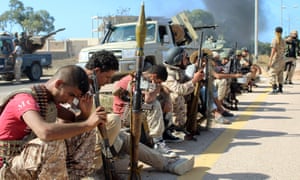09.06

Patrick Vintour- Chris Stephen
Libyan forces claim to have reached the centre of the coastal city of Sirte, Islamic State’s key stronghold, meaning the jihadi group may have lost all territorial control in the country.
The speed of the apparent rout of Isis after three weeks of heavy fighting is extraordinary given US intelligence was suggesting only two months ago that the group had 6,000 fighters in the city and was starting to pose a threat to neighbouring Tunisia.
Although it is still possible that the Isis retreat is tactical, most observers believe the military offensive has revealed Isis to be far weaker in Libya than many had thought.
Thursday’s assault was mounted from three directions, with some aerial strikes on the Ouagadougou conference hall, considered the administrative hub of Isis in Libya. By late afternoon the Libyan navy was claiming the city had been fully taken.
Videos circulated on social media showing triumphant militiamen flashing victory signs and chanting “Allahu Akbar” or “God is Great” as they drove around Sirte. Forces from Misrata, aligned with Tripoli’s UN-backed government, posted photographs showing they had captured the area around an iconic billboard previously used by Isis to display the bodies, clad in orange jumpsuits, of those it had executed. The billboard, at the town’s Zafaran intersection, was torn down as militias pushed towards the city centre.
The territorial gains, as well as the apparent killing of some of the most senior Isis commanders, have come at a price. The UN-backed Government of National Accord appealed to the west for urgent medical help for its wounded fighters. It has been claimed that more than 100 Libyans have been killed and 490 wounded while trying to drive Isis out of Sirte.
The attack appears to have been mounted by two militia brigades from Misrata, including Al-Bunyan Al-Marsoos, a militia able to call up air support. There have also been forces from the Petroleum Guard from the west of the country and some from Tripoli.
Mattia Toaldo, a Libya expert at the European Council of Foreign Relations, said: “If the reports from the joint command are partially true, they at least are in the town centre. If they are fully true, they have reached the administrative headquarters of Isis. If that is the case we are talking about hours from the end, and not days. The rate of progress is far faster than anyone predicted even two days ago.”
Toaldo said it suggested Isis had failed to gain the support of Sirte residents.
He added: “It may well be that the estimates of the number of Isis fighters in Sirte has been greatly exaggerated and talk of 6,000 fighters was wrong, and instead it was closer to 700. If the Misratan forces are making this speed of progress, they will have been helped by western intelligence on the ground.”
He said the forces coming from three different parts of Libya probably had no interest in staying in Sirte longer than necessary and would want to pass responsibility to the town’s elders and former authorities.
He cautioned: “It dos not mean that Isis has been ended in Libya if Sirte falls. The example of Isis in Baghdad shows that if they lose territory they resort to terrorism, and it may be they have sent their forces into the desert in order to regroup or prepare to strike later in Tripoli.”
Some observers said there was a chance the heaviest fighting in Sirte may still be ahead, with Isis fighters now potentially trapped with their backs to the sea. “It’s difficult to tell if Islamic State in Libya has been weakened by the offensive because we don’t really know what its troop strength is,” said the US analyst Geoff Porter. “The battle for Sirte may be long and bloody.”
The absence from the offensive of General Haftar, the strong man in the east of Libya and the chief ally of Egypt, is likely to be politically significant; posing a challenge to his effort to present himself to other countries as the chief interlocutor in the east. He has been losing recruits to the GNA Ministry of Defence, but he remains powerful and the single biggest force preventing the formation of a unified army and country.
Isis lost its base at Derna, in north-east Libya, to local forces last year, and in February its western Sabratha base was destroyed by militias and US airstrikes, leaving Sirte its last remaining stronghold.
Cap comentari:
Publica un comentari a l'entrada